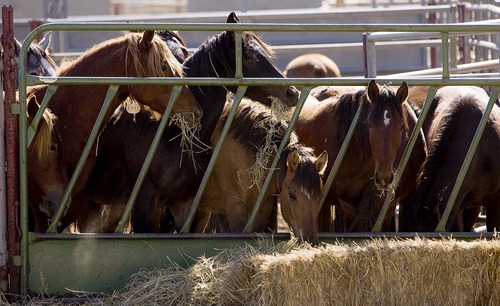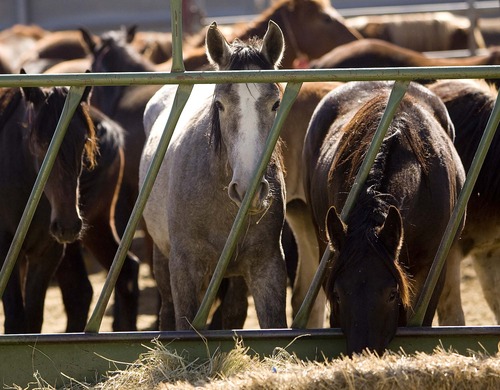This is an archived article that was published on sltrib.com in 2012, and information in the article may be outdated. It is provided only for personal research purposes and may not be reprinted.
They are seen as an icon of the West, living history of a big, bold land that still stirs the American imagination.
But the wild horses that roam federal rangeland across 10 Western states and the Bureau of Land Management that oversees them stand at a precarious crossroad.
On one hand, the BLM will begin considering neutering horses on the range as a way to keep down populations. On the other, thinning herds too much will lead to a lack of genetic diversity that could threaten future generations.
New management strategies are being considered because the agency's Wild Horse and Burro Program, as is now formulated, appears unsustainable: 47,000 horses and burros have been taken into captivity with little chance of adoption, and their fate is uncertain because of the cost to maintain them; the estimated 37,000 animals remaining on the range will almost double in number in the coming four to five years; and the 179 herds that make up that population face an ongoing drought in the West that is leading to reduced forage on the 31.6 million acres where they are allowed to roam.
"Adoption [as a population control strategy] is no longer a logical way to proceed," said Dean Bolstad, deputy division chief for BLM's Wild Horse and Burro Program. "We cannot continue to increase the numbers of horses in captivity."
But the BLM has set at 26,600 the optimal number of horses for the public rangeland under its multiple-use management paradigm, which must also accommodate 3 million grazing cattle and provide forage for deer and elk on the total 244 million acres it controls.
As such, the BLM must continue roundups to keep mustang numbers in check. But wild horse managers, who have practiced some contraceptive measures in the past, must be more aggressive with birth control, Bolstad said.
Not least, the BLM will "consider" spaying mares and gelding stallions in the wild, Bolstad said. The program's advisory board endorsed that strategy at a meeting in Salt Lake City last month.
That is an outrage to wild horse advocates, said Ginger Kathrens, executive director of The Cloud Foundation.
She maintains the agency has given short shrift to the use of "PZP," an injectable contraceptive that provides good results but is not permanent. She fears sterilization could negatively impact genetic diversity.
The number of horses in captivity exploded under President George W. Bush and continues under President Barack Obama, Kathrens said.
"Instead of removing them [from the range] why not use a tried and true [contraceptive] drug?" she said. "It shows you, they would rather remove the animals or mutilate [spay] the mares and geld the stallions."
Public grazing land for wild horses and burros has decreased about 22.2 million acres from 53.8 million acres originally outlined in the 1971 law.
Part of the challenge is political, said Pat Shea, the Salt Lake City attorney who headed up the BLM from 1997 through 1999, under President Bill Clinton. Cattle interests have a strong lobby, while wild horse activists don't, he said. Congress bends toward the cattlemen but is largely disinterested in mustangs.
During his tenure, Shea said, the agency returned 10,000 animals to private rangeland, was aggressive with contraception and began gelding wild stallions.
Kathrens, and other activists, would like to see the range extended and individual horse herds well above 150 to 200 adult animals needed to ensure genetic diversity.
Gus Cothran, professor of veterinary and biomedical sciences at Texas A&M University, contracts with the bureau to track genetic diversity in the herds. He said that although many BLM herds are smaller than 150, none show ill effects of a reduced gene pool — yet.
"The herds are very small, and that will lead to a lack of genetic diversity, given time," he said.
Once a herd's gene pool has been reduced, allowing its numbers to grow will not bring back genetic diversity, Cothran said. However, there is a remedy for a reduced gene pool in any herd, and that is to introduce breeding-age animals from another herd.
Some of the herds date back to the Spanish conquistadors, and activists like Kathrens say their integrity should not be compromised by introducing outside horses to buoy genetic diversity. That is among the reasons they believe herd sizes should be expanded before genetic variability is threatened.
"The BLM doesn't have the will to manage horses in a humane, sane way," she said.
But Bolstad said the agency is working to protect the wild horse and burro populations. However, even if rangeland and horse populations were allowed to double, the BLM would still be faced with the population control, he said.
"We need to consider more tools," Bolstad said. "No one strategy will solve the [wild horse] management issue."







